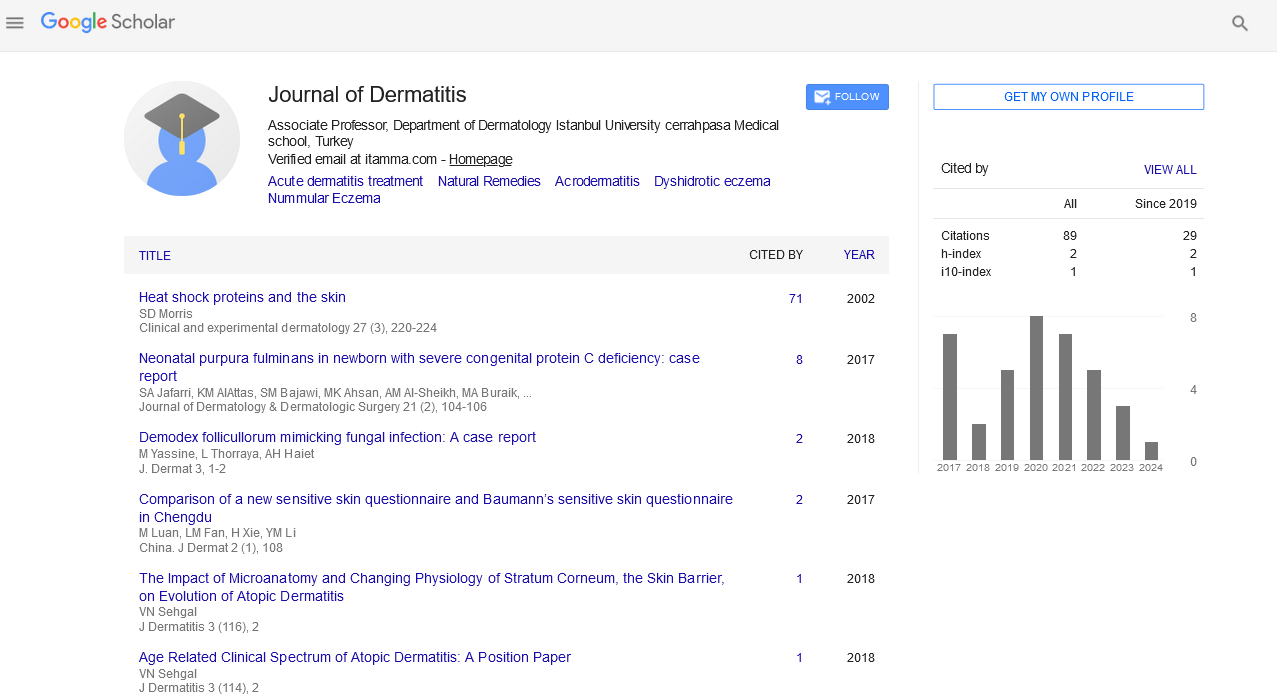Indexed In
- RefSeek
- Hamdard University
- EBSCO A-Z
- Euro Pub
- Google Scholar
Useful Links
Share This Page
Journal Flyer

Open Access Journals
- Agri and Aquaculture
- Biochemistry
- Bioinformatics & Systems Biology
- Business & Management
- Chemistry
- Clinical Sciences
- Engineering
- Food & Nutrition
- General Science
- Genetics & Molecular Biology
- Immunology & Microbiology
- Medical Sciences
- Neuroscience & Psychology
- Nursing & Health Care
- Pharmaceutical Sciences
Perspective - (2025) Volume 10, Issue 1
Non-invasive Assessment of Immune and Lipid Disturbance in Seborrheic Dermatitis
Ferran Lens*Received: 25-Feb-2025, Manuscript No. JOD-25-29122; Editor assigned: 27-Feb-2025, Pre QC No. JOD-25-29122 (PQ); Reviewed: 13-Mar-2025, QC No. JOD-25-29122; Revised: 20-Mar-2025, Manuscript No. JOD-25-29122 (R); Published: 27-Mar-2025, DOI: 10.35248/2684-1436.25.10.265
Description
Seborrheic dermatitis affects up to 5% of the general population and presents with erythema, greasy scales and intermittent itching. Though typically localized to the scalp, nasolabial folds, eyebrows and upper chest, it can extend to other sebaceous areas. SD is considered a chronic and relapsing condition influenced by environmental, microbial, hormonal and immune factors.
Historically, diagnosis and treatment have relied primarily on clinical assessment. However, this approach overlooks subclinical features and underlying molecular changes that may contribute to symptom persistence and recurrence. The use of tape-strip sampling where adhesive strips are applied and removed from the skin to collect stratum corneum material has emerged as a minimally invasive and efficient method to assess cutaneous pathology at the biochemical and immunological levels.
Seborrheic dermatitis
The pathogenesis of SD involves a complex interaction among epidermal barrier dysfunction, innate and adaptive immune responses and the activity of Malassezia species, a commensal yeast thought to contribute to disease flare-ups. Barrier integrity is often compromised in SD, leading to enhanced transepidermal water loss and increased susceptibility to irritants and microbial products.
Tape-strip sampling
Tape-stripping involves the repeated application of a specialized adhesive strip to the skin’s surface, allowing for the removal and collection of corneocytes, extracellular matrix proteins and superficial immune cells. The material collected can then be analyzed through a variety of molecular techniques, including transcriptomics, proteomics and lipidomics.
Compared to invasive biopsy, tape-stripping offers significant advantages in patient comfort, repeatability and feasibility in longitudinal studies. It allows researchers to monitor biochemical processes in real time, across different body sites and disease stages, making it particularly well-suited for chronic conditions such as SD.
Immune dysregulation
One of the most revealing aspects of tape-strip profiling in SD is the ability to quantify cytokine and chemokine activity directly from the stratum corneum. Patients with active SD show elevated levels of pro-inflammatory markers, even in areas that may appear only mildly affected.
Comparative insights
Tape-strip profiling allows for the comparative analysis of SD with other inflammatory dermatoses such as psoriasis, atopic dermatitis and rosacea. Unlike psoriasis, where IL-17 and IL-22 dominate the cytokine profile, SD exhibits a mixed pattern of Th1, Th2 and Th17 activity, albeit at lower magnitudes.
Additionally, while atopic dermatitis often shows elevated IL-4 and IL-13 levels in both lesional and non-lesional skin, these markers are less prominent in SD. Instead, SD’s immune activity appears more localized, suggesting different mechanisms of pathogenesis and disease spread.
From a lipid perspective, the degree of ceramide depletion in SD is typically less than that seen in atopic dermatitis but still sufficient to impair barrier function. This supports the hypothesis that SD occupies a unique position on the spectrum of inflammatory skin diseases, influenced by both endogenous (lipid metabolism) and exogenous (microbial) factors.
Clinical applications and predictive value
Understanding immune and lipid imbalances through tape-strip profiling holds value in clinical management. Patients with elevated inflammatory markers may benefit from prolonged or adjunctive therapy, even in the absence of pronounced clinical symptoms. This approach could support individualized treatment planning and help reduce recurrence rates.
Furthermore, lipid profiling may guide recommendations regarding emollient use or adjunctive barrier repair therapies. Patients exhibiting significant ceramide deficiencies may respond better to products enriched with skin-identical lipids.
Monitoring treatment response through serial tape-strips could also enable early detection of therapeutic resistance or incomplete resolution of inflammation, providing an objective parameter to adjust therapy.
Tape-strip profiling has emerged as a powerful technique to investigate the immune and lipid alterations associated with seborrheic dermatitis. The identification of elevated pro-inflammatory cytokines, impaired lipid synthesis and oxidative byproducts provides a more nuanced understanding of this common skin condition. These insights not only enhance diagnostic accuracy but also support the development of more effective and comprehensive treatment strategies. Continued integration of non-invasive biomarker analysis into clinical practice has the potential to improve outcomes and personalize care for individuals living with seborrheic dermatitis.
Citation: Lens F (2025). Non-invasive Assessment of Immune and Lipid Disturbance in Seborrheic Dermatitis. J Dermatitis. 10:265.
Copyright: © 2025 Lens F. This is an open-access article distributed under the terms of the Creative Commons Attribution License, which permits unrestricted use, distribution, and reproduction in any medium, provided the original author and source are credited.

